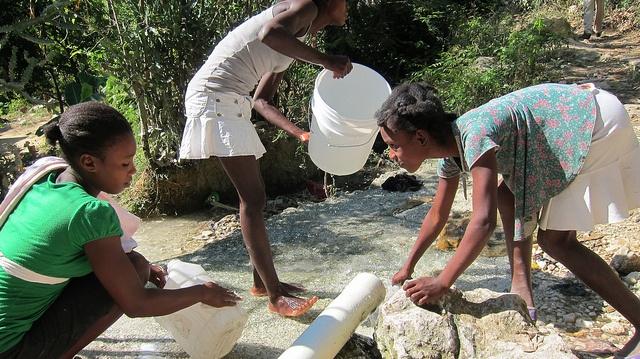Trump's Suits Skirt the Legal Definition of Made in the U.S.A


Donald Trump's unusual definition of "Made in USA" is no secret these days. It seems like everyone, including his dogmatic opponent, Hillary Clinton, has pointed out that what he thinks is good for American businesses isn't necessarily what he maintains is good for his own enterprises.
Recently Buzzfeed went a step further and dug into the advertising that has gone along with some Trump products.
"[The] online retailer seems a little confused about where the suits were made," wrote Daniel Wagner, a reporter for Buzzfeed. "It lists some of them as both 'Imported' and 'Made in USA.' Those can’t both be true, right?"
A good point. So Buzzfeed ordered a couple of suits through Amazon, the online retailer featuring Trump's apparel for men, to get to the source of the mystery. Their financial outlay of somewhere between $300 and $600 revealed an interesting answer: The label on the suit listed the product as having been made overseas. Unlike the advertising information on Amazon, there was nothing on the label that said that the suit was made in the U.S.
Buzzfeed's story must have made quite a commotion, because this weekend the references to both "made in USA" and "imported" were taken out of the product descriptions (see the Buzzfeed link above to see a screenshot of the original wording). Amazon no longer appears to offer Trump's made-in-USA suits.
The FTC's made in USA definition
Still, the issue of how Trump could advertise a product (or a product line) as made in the USA and have them assembled elsewhere was still too interesting to pass up. So we decided to dig a bit further.
Just what is it that a manufacturer has to do to stamp that iconic claim on a product's advertising? More to the point, is it actually legal to say something is made in the USA and imported?
The short answer is, yes. The longer one is of course, as long as the product meets federal requirements. And that's where Trump's (presumably former) claim gets hazy.
According to the Federal Trade Commission (FTC) all textile manufacturers are required to state if they are made in the U.S. And if they have been manufactured in more than one country, they have to state that as well.
"For a product to be called Made in USA, or claimed to be of domestic origin without qualifications or limits on the claim, the product must be "all or virtually all" made in the U.S. The term "United States," as referred to in the Enforcement Policy Statement, includes the 50 states, the District of Columbia, and the U.S. territories and possessions."
The FTC calls this the "all or virtually all standard." In other words, says the agency: "All or virtually all" means that all significant parts and processing that go into the product must be of U.S. origin. That is, the product should contain no — or negligible — foreign content."
As a writer, I sometimes wonder if peculiar wording has something to do with how companies and consumers interpret laws the government makes. It shouldn't, but the FTC's Textile Fiber Rule is a boon for bored grammarians.
Merriam Webster's simple definition to virtually (adverb) is "very nearly, almost entirely." One would assume that means that all or very nearly all of the suit that is being marketed as having been made in the USA was actually manufactured domestically. But the the Free Dictionary, which takes a more modern interpretation that might fit, say, the use of virtual reality concepts, expounds on this minute definition by adding the following: (adverb) "in effect though not in fact; practically; nearly."
So a product that consumers think was made in the USA, could be "in effect, though not in fact, or practically" made in America. And nothing in this generous FTC rule seems to state what the limit is that defines practically.
Foreign content: None, neglected or unimportant?
The same is true for the question of foreign content. According to the the FTC's rule, the suits that carry Donald Trump's Made in USA label "should contain no -- or negligible -- foreign content." But there it is again: the perfect potential giveaway.
Merriam defines 'negligible' as "so small or unimportant or of so little consequence as to warrant little or no attention." The Shorter Oxford English Dictionary, however, defines the meaning as "capable of being neglected or disregarded."
And in neither case does the Textile Fiber Rule offer suggestions as to how little or how much can be present in a suit that has been advertised as "Made in USA."
Trump suits: But (did) they comply?
For the consumer looking to purchase a suit that is (presumably) USA made, Amazon's advertising fits the bill. And the advertising is right in line with what the FTC requires: It notes that the product was both imported and of USA origin. But what Trump's product -- at least the ones featured and sold to Buzzfeed -- didn't do, was clarify to shoppers that the product was assembled in the USA. It also didn't follow the FTC's rule when it comes to clarifying the manufacturing process that was used in the two (or more) countries (Textile Fiber Identification Act, 303.33.4). And most importantly, it doesn't mention anywhere on the country of origin label that it was made in the USA.
Presidential candidates' claims sometimes shine a spotlight on problematic regulations that might normally have received negligible attention. But in this case, Trump's repeated suggestion that products should be manufactured in the USA (and not take advantage of free trade agreements as his products often have) appear to have circled back on his campaign. They raise more questions about his companies' business approaches than about the trade provisions that he is so critical of.
Ironically, the question of whether one can call for an end to trade deals and at the same time, use companies overseas to manufacture goods is debate that the presidential candidate seems to have realized isn't good for his campaign -- at least as far as his hats go. He now offers a selection of higher-priced ball caps for those appearance-savvy Trump followers who want to boast that their apparel is "100 percent Made in USA." And boast they'll have to do, because the new, higher priced USA caps look virtually the same as those he had manufactured in foreign countries.
Images: Made in USA label - Flickr/Mark Morgan
As the Election Heats Up, Voters Could Propel Carbon Taxes


By Zach Bernstein
All eyes are on the presidential election. But it’s important to remember that, come November, Americans will be voting for far more than just who will lead the country.
Some Americans, for example, could be voting to completely alter how we tackle climate change.
That’s because voters in Washington state will decide whether their state becomes the first in the country to pass a carbon tax. The ballot initiative, Initiative 732, would create a tax on fossil fuels and electricity generated from coal and natural gas.
While Washington isn’t the only state currently considering a carbon tax, it’s the only one that’s putting the question directly to the voters. For that unique reason, it’s the carbon tax proposal to watch over the next few months.
Power to the people
The idea of asking people to vote on a carbon tax might seem outlandish, but Washington State is actually not the first place to do it. Voters in Boulder, Colorado backed a carbon tax in the 2006 election, and voted again in 2012 to keep the tax in place for at least five more years. That’s right: An American city actually voted for a carbon tax twice.
Now, the usual caveats apply: we are talking about a city sometimes referred to as “The “People’s Republic of Boulder.” Nevertheless, Boulder’s experience offers a powerful model for other places looking to pass a carbon tax. Boulder’s plan taxes electricity consumption and puts the revenue towards energy efficiency and renewable energy programs, with the goal of bringing the city’s emissions levels in line with the Kyoto Protocol.
As of 2012, Boulder had brought in between $600,000 and $1.8 million a year from the carbon tax. While the city hasn’t been able to meet the Kyoto Protocol goals, its greenhouse gas reductions have been significant. Also important, the costs have remained manageable: In 2012, costs to businesses were about $94 each, and costs to households about $21. No wonder voters, given two chances to stop the carbon tax, voted to go ahead with it!
Going Evergreen
So what about Washington State’s carbon tax plan? Unlike Boulder’s, it would be revenue-neutral: all money the tax brought in would be used to offset other taxes or distributed back to the population. In this case, the carbon tax would be offset by lowering the sales tax and eliminating a tax on manufacturers; and distribution would be a rebate to low-income families who might be more affected.
The tax would start at $25 per metric ton of carbon emissions, then rise every year by 3.5 percent plus the rate of inflation. This annual increase is important, as a major goal of a carbon tax is to ensure that significant downward pressure on fossil fuels continues well into the future. It doesn’t do much good to put a new tax on fossil fuels if the value will decline over time -- if that were to happen, producers would eventually be able to more easily absorb the cost, and emissions would rise once again.
What also makes Washington interesting is that most of the state’s energy already comes from low- or no-carbon sources. The single biggest generation source is hydropower, comprising 68.5 percent of the state’s electricity mix. Natural gas comes next, at 15.6 percent -- but since natural gas emits far less carbon than coal, it would incur lighter taxation.
A state-based tax isn’t ideal -- some Washington businesses, especially in industries like pulp and paper manufacturing and steel production, worry about competing with other firms in states without carbon taxes. But if enough states decide to take on carbon taxes on their own, it could push Congress to act and set up a single, nationwide carbon tax to eliminate confusion.
Rock the vote
What makes Washington State’s potential carbon tax most interesting isn’t that its policy is particularly groundbreaking. It’s that voters will get the final say. If Initiative 732 is successful, it could signal a major shift in how voters think about climate change – and that could mean a shift in how policymakers address it.
Currently, there is no polling on how the Washington State initiative will fare, although somewhat surprisingly, some environmental groups are opposed to the plan because it does not set aside funding for environmental programs as Boulder did with its tax.
Whether to make a carbon tax revenue-positive -- devoting revenue to solutions like infrastructure or further carbon reductions -- or revenue-neutral, is a major debate point. Both sides have strongly held views. In many cases, revenue-neutrality is a nod to political reality; asking voters to grow government isn’t always a winning strategy. For groups like the American Sustainable Business Council, which backs the idea of a carbon tax, revenue-neutrality is acceptable as long as other principles are met.
Which brings us back to the importance of this election. If Initiative 732 passes, that will send a big signal to policymakers that a carbon tax might not be a political loser, and might even open the floodgates for more states to pass carbon taxes of their own. If that happens, Congress could end up getting on board faster than we think. If the initiative fails, supporters of a carbon tax will likely learn more about how to present such a vital policy more successfully to the public next time.
One thing is certain: Washington State’s initiative won’t have an easy path to victory. And there’s still vigorous debate over what the best carbon tax plan would look like. But come November, the debate over how to address climate change could look very different. Like every other decision with worldwide repercussions, it will all come down to how the people vote.
Image credit: Pixabay
Zach Bernstein is Manager of Research and Social Media for the American Sustainable Business Council.
3p Weekend: Innovative Reuse Can Solve Our Waste Problem


With a busy week behind you and the weekend within reach, there’s no shame in taking things a bit easy on Friday afternoon. With this in mind, every Friday TriplePundit will give you a fun, easy read on a topic you care about. So, take a break from those endless email threads and spend five minutes catching up on the latest trends in sustainability and business.
America has a staggering waste problem. We generate over 250 million tons of trash each year, according to the EPA, and our recycling rate is stagnant at around 34 percent. The remainder ends up in our ever-swelling landfills, which number in the thousands. (If you're still not convinced of this growing crisis, check out this interactive map that shows how quickly landfills have ballooned across the country.)
As governments and advocacy groups rally to convince Americans to recycle more, greater innovation is needed to spur reuse and recycling -- and create profitable end-uses for recovered material.
To examine how innovative reuse and recycling can address our growing waste problem, we broke down America's largest waste streams (according to EPA data) and highlighted company and nonprofit efforts that cut them down to size.
Paper: 27 percent of our waste stream
Americans generate a staggering 68 million tons of paper and paperboard waste every year, according to the most recent EPA data. The good news is that paper has a 63 percent recovery rate, the highest among our common waste materials.
That said, paper recovery and reuse presents a challenge: Since paper fibers shorten and degrade during the recycling process, paper is usually downcycled -- leaving company execs racking their brains for innovative applications for recovered paper.
Headquartered in San Rafael, California, PulpWorks may have cracked the code. Co-founded by Paul Tasner, an alum of sustainability darling Method, PulpWorks uses post-consumer recycled paper to replace those annoying blister packs in packaging (typically made from PVC, a hard-to-recycle plastic resin).
The resulting packaging is frustration-free and completely compostable at end-of-life. The product received accolades the world over, including placing as a finalist in the Sustainable Brands Innovation Open in London in 2013.
Food: 14.6 percent
https://youtu.be/WREXBUZBrS8
The U.S. wastes up to 40 percent of all the edible food it produces. Put another way: On average, every American family loses $1,600 to $2,000 each year to food that is purchased but not eaten. That loss is more than what it costs to feed a family of four for an entire month -- a heartbreaking statistic considering 48.1 million Americans live in food insecure households.
The best way to prevent food waste is to reduce it at the source. But even when employing best efforts, U.S. households and businesses often still see leftovers end up in the bin. To tackle this problem on the business level, the EPA and the U.S. Department of Agriculture launched the U.S. Food Waste Challenge to educate and incentivize small businesses to reduce food waste. At the municipal level, cities like Seattle and San Francisco offer curbside composting to ensure that uneaten food can be put to good use rather than languishing in a landfill.
But by far the highest-value way to reduce food waste is to recover the material while it is still edible and re-route it to hungry families and individuals. Due to continued advocacy from stakeholders ranging from national nonprofits to celebrity chefs, the food waste problem is finally emerging on the national stage -- and, thankfully, so are food-rescue organizations.
City Harvest collects thousands of pounds of edible food daily in New York City; Food Shift and FoodRunners do similar work in the San Francisco Bay Area; and dozens of other groups are working to recapture food waste and eliminate hunger across the country. To find a solution near you, check out the food rescue locator from Sustainable America.
Plastics: 12.8 percent
In only a few decades, plastic has emerged as a ubiquitous aspect of American life. We generate over 32 million tons of plastic waste annually. While it's crucial to increase the recovery of plastics -- only 3 million tons were recycled in 2013 -- it's equally vital to create end-use applications for the material in order to keep the recycling process economically viable.
Luckily, a growing number of American companies are turning to recycled plastic as a feedstock -- and they're emerging as cult favorites among the sustainability set. Founded in 1996, household products company Preserve was one of the first of such companies to emerge on the scene.
The Certified B Corp creates kitchen, bath and tabletop items from 100 percent recycled No. 5 plastic. This resin, which is used for common packaging items like yogurt cups, isn't accepted in many curbside programs -- meaning the bulk ends up in our landfills. Preserve not only offers stylish (and recyclable) items made from No. 5 plastic, but also provides drop-off locations for the material in partnership with Whole Foods Market. In addition to your yogurt cups and butter tubs, Preserve will also take back any of its products -- from tableware to toothbrushes -- for recycling.
Textiles: 9 percent
Americans generate over 15 million tons of textile waste annually, according to the most recent EPA data. The vast majority (almost 85 percent) of this unwanted clothing and other textiles is sent to our landfills. But 95 percent could be reused or recycled, according to the 2016 State of Reuse Report from global thrift retailer Savers.
"Since many synthetic fabrics cannot be recycled, reuse provides a second life, possibly even a third or fourth life, for clothing and other textiles and keeps them out of landfills," Tony Shumpert, vice president of reuse and recycling for Savers, wrote in an op/ed on TriplePundit. "Confusion over what is recyclable and reusable plays a key role in adding to the 26 billion pounds of textiles people sent to landfills each year."
Some have qualms about donating those ripped jeans or stained T-Shirts to a local thrift store. But thrift retailers like Savers will responsibility direct every scrap of your unwanted textile waste. Unsellable items are recycled into necessities like cleaning towels and insulation. And for wearable garments, Savers in particular has a multifaceted reuse solution that keeps on giving.
Through longstanding relationships with nonprofit partners, Savers turns unwanted clothing into donations for groups like Big Brothers Big Sisters. That means last season's jacket can not only find a new wearer, but also help create a new life for an at-risk child. Talk about a win-win!
Metal: 9 percent
When it comes to reuse and recycling, metal is something of a wonder material. Most metals are infinitely recyclable and do not lose quality during the recycling process. Even better: Using recycled metal actually saves money and energy compared to virgin feedstocks.
With this information in mind, you'd think U.S. metal recycling rates would be a bit higher -- we recovered around 34 percent in 2013. But the good news is that, when metal is recovered, it often returns to its original use -- creating something of a closed loop.
Take, for example, the most common household metal: aluminum. Due to seamless recycling, recycled aluminum can be turned into a new beverage container and appear back on a store shelf in as little as 90 days.
And the average beverage can is increasingly made from recycled material. Last year, aluminum processing firm Novelis announced a beverage can made from 100 percent recycled aluminum, with an impressive 90 percent coming from post-consumer content. Alcoa earned Cradle to Cradle certification for some of its products, an industry first, and is largely behind urging the industry to achieve a 75 percent recycling rate.
What do you think about these innovative recycling and reuse applications? Will they encourage you to recycle more? Tell us about it in the comments section or on social media using the hashtag #RethinkReuse.
Image credits: 1) Pexels; 2) PulpWorks; 3) Preserve; 4) Courtesy of Savers/Value Village; 5) Pexels
Video courtesy of the Ad Council
Enterprise Rent-A-Car Shirks 'Green' Cred, Joins ALEC


Enterprise Rent-A-Car has long touted its “green” credentials, from being the first in its industry to issue a sustainability report to adding hybrid cars to its U.S. fleet. The company also promotes itself as a leading corporate citizen, most recently with its assistance in relief efforts after the devastating Louisiana floods. But the recent revelation that the self-described world’s largest car rental agency is now a paying member of the American Legislative Exchange Council (ALEC) threatens to damage the company’s reputation.
As first reported in the Guardian, the company’s ALEC membership caught the attention of the Center for Media and Democracy. The Madison, Wisconsin-based advocacy organization has been a leading critic of ALEC. The Center describes ALEC as a front for industry groups seeking to rewrite laws that undermine public policy, from the implementation of clean energy to more stringent regulations on pesticides. Earlier this year, an ALEC-inspired bill that prohibited cities in Wisconsin from banning plastic bags was passed into law by the state's legislature. Opponents of ALEC slammed the organization for sending legislators pre-drafted laws that, in the end, allow its clients to avoid regulations, taxes and any measures that would have an impact on their revenues.
The backlash against ALEC and its tactics have spooked some of the world’s largest companies, including energy giant BP, the automaker Ford Motor Co., online auctioneer eBay and CPG giant Johnson & Johnson to sever ties with the lobbying group.
Enterprise defended its engagement with ALEC over what it says are unfair car rental excise taxes, Sam Thielman wrote in the Guardian. Indeed, in an era in which citizens are loath to pass any tax increases, levies on visitors -- including hotel and car rental taxes -- are seen as an easy way to raise revenues for projects such as new sports stadia or providing salary raises for teachers. In 2014, for example, an Arizona judge ruled that a car rental tax was unconstitutional because those fees under that state’s constitution should have been used for road and highway maintenance, not a football stadium or hockey arena.
And Enterprise can certainly use that case as precedent to explain why car rental taxes are punishing to car rental companies and unfair to consumers. Unfortunately for Enterprise, its alignment with ALEC threatens to harm the relationships it has with many of its stakeholders. And considering that another company in the wider hospitality industry, Expedia, cut its ties to ALEC earlier this month, Enterprise finds itself standing alone. At a minimum, the optics are bad. At worst, Enterprise could lose trust and damage its brand. As the Daily Kos reported earlier this week, “It seems that Enterprise has become more concerned with local taxes and lost sight of its duty to be responsible stewards of the communities where it does business and its employees and customers live.”
In its aversion to paying local taxes, Enterprise’s membership could be helping ALEC fund other initiatives that go against the company's so-called values. And that is why the surprise and outrage at Enterprise’s decision has been loud and rapid.
Image credit: Paul Kimo McGregor/Flickr
Donald Trump's Hidden Agenda: White Nationalist Media Mogul?


What are Donald Trump's true aspirations in his bid for the presidency? A new TV show with higher pay? Eternal fame with adoring fans?
Checkmark on that last one. Pundits have been expounding lately on what drives Trump – other than big “Mexican” taco bowls and an insatiable appetite for large crowds. What keeps him going late at night, knowing that large sectors of the Republican party have either written him off completely or are desperately trying to form an intervention to his election?
“Donald Trump never actually wanted to be president of the United States,” writes filmmaker and author Michael Moore. "Trump was unhappy with his deal as host and star of his hit NBC show, 'The Apprentice' (and 'The Celebrity Apprentice'). Simply put, he wanted more money." According to Moore, who said he has the information on good standing, the run for presidency was just a ruse that was supposed to last for a couple of months, nothing more. NBC, the network behind "The Apprentice," would be sure to see the merits of his celebrity status and offer gads more money.
Washington Post writer Greg Sargent takes things a step further. He says even duping American voters (and taxpayers' coffers that are covering some of the costs of his run) would seem banal for a man who thrives on trying to build the biggest skyscrapers and commanding a TV character whose prime line was, "You're fired!"
Sargent, who has written extensively on the Republican candidate, suggests that Trump's real intention all along was to establish an all-white following that would allow him to "pivot" his attention toward creating a media network supporting far, far right perspectives. And Sargent is not alone.
Just look at Trump's spending priorities, suggests New York Times writers Nicholas Confessore and Rachel Shorey, who point out that Trump's focus has been antithetical to a party win-all mentality.
Sargent expounds: "Trump is very consciously sinking most of his resources into a format (rallies) that allows him to continue staging his unique form of raucous WWE-style political entertainment, and building an audience that thrills to it, rather than winning a general election."
The candidate's recent hiring of Stephen Bannon, founder of Breitbart News Network as campaign chief suggests Trump is keenly aware of the genre of fans his rallies will to continue to attract: individuals who would benefit from and support more validation of views not considered generally acceptable in mainstream media. Bannon has been immensely successful at creating a go-to space for what he refers to as the "alt-right" (or "white supremacists"as one Breitbart insider also noted).
But not everyone seems convinced that Trump has an ulterior motive and is using the chaos of his campaign to build a mega-media status.
"[It’s] time we stopped assuming that Trump has something we could call a coherent strategy — or ever will," argues Washington Post writer Paul Waldman. "It’s increasingly apparent that both the man himself and his campaign have a competing pair of impulses."
In Walman's perspective, Trump's campaign chaos isn't a strategy toward achieving something grander than himself, but a reflection of his true inability to manage a presidential campaign.
Whatever theory you choose, the real takeaway may be what it means for the American political system.
"Trump could change the race by stamping his image upon the Republicans in a way they cannot escape. Trump has made himself the symbol of racism against Latinos in the United States," concludes Jonathan Chait, a writer for New York magazine. "He is absolute brand poison."
And while Democrats may want to call such conclusions the ice cream on the cake that they'll be ordering when Hillary Clinton wins the White House, it bodes problems for a country molded by a two-party system that has its origins in the founding of the republic and the culture of a nation. Irrespective of his motives of fame and fortune, it will likely be the legacy he leaves on how and why we choose to vote that will resonate the loudest after this election is over.
Image: Flickr/Marc Nozell
U.N. Finally Acknowledges Its Role In Haiti Cholera Epidemic


When United Nations troops are sent to an area affected by a natural disaster, they are there to help. But after the Haitian earthquake in 2010, many say these troops were the cause of a cholera epidemic.
Until recently, the U.N. denied its responsibility. However, it has finally acknowledged its role in the cholera epidemic. In an email obtained by the New York Times, Farhan Haq, deputy spokesperson for U.N. Secretary General Ban Ki-moon, said: “Over the past year, the U.N. has become convinced that it needs to do much more regarding its own involvement in the initial outbreak and the suffering of those affected by cholera.”
A catastrophic earthquake hit Haiti in January 2010 and killed more than 200,000 people, displacing over 1 million. Ten months later, the Haiti National Public Health Laboratory identified cholera as the culprit behind a sudden increase in Haitians with watery diarrhea and dehydration. Officially 9,200 Haitians died from cholera, but a Doctors Without Borders study finds it could be higher, the New York Times reported in June.
The cholera epidemic was a first for Haiti, the poorest in the Western hemisphere, which never experienced an outbreak of the disease. Cholera is a disease that if untreated can cause death in less than two days, but it is treatable with oral rehydration salt solutions, intravenous fluids or antibiotics. The main transmission method is ingesting contaminated water. After the outbreak began, rumors pointed to U.N. troops from Nepal as the source. The Haiti National Public Health Laboratory collected stool samples from cholera patients when the outbreak started and sent them to the U.S. Centers for Disease Control and Prevention (CDC) to analyze. What the CDC found is that a single strain likely caused the outbreak and was introduced into Haiti in one event.
A 2011 study done by a team of French and Haitian researchers created a database of cases. They found “significant clusters” of cholera outbreaks near Mirebalais next to a U.N. camp “with deficient sanitation.” They also found that cholera “more severely affected communes in the coastal plain along the Artibonite River downstream of Mirebalais.” Their findings “strongly suggest” that contamination of the Arbonite River and one of its tributaries located downstream from the UN military camp “triggered the epidemic.”
Something could have been done to prevent the cholera epidemic. A study released in January found that interventions “would have impacted the likelihood of the Haiti cholera epidemic.” Researchers concluded that screening, giving medications to prevent infection and vaccination are “all effective strategies to prevent cholera introduction during large-scale personnel deployments such as that precipitating the 2010 Haiti outbreak."
How much responsibility did the U.N. take for its role in the cholera epidemic? Not enough. Wrote Jonathan M. Katz of the New York Times: “[The acknowledgement] stopped short of saying that the United Nations specifically caused the epidemic ... nor does it indicate a change in the organization’s legal position that it is absolutely immune from legal actions, including a federal lawsuit brought in the United States on behalf of cholera victims seeking billions in damages stemming from the Haiti crisis.”
In 2013, a federal lawsuit was filed in the Southern District of New York after prior claims against the U.N. demanding accountability for the epidemic were ignored. The claims demanded that the U.N. take steps to prevent another cholera epidemic by installing a national water and sanitation system in Haiti. Complainants also demanded the U.N. provide compensation to cholera victims for losses and issue a public apology. The U.N. maintains that it is immune from lawsuits, including the federal lawsuit.
A confidential report was sent to the Secretary General by U.N. adviser Philip Alston, the New York Times reported. The report states that the cholera epidemic “would not have broken out but for the actions of the United Nations.” Alston characterized the U.N.’s Haitian cholera policy as “morally unconscionable, legally indefensible and politically self-defeating.”
The email sent by the Secretary General’s office stated that a “new response will be presented publicly within the next two months, once it has been fully elaborated, agreed with the Haitian authorities and discussed with member states.”
Hopefully that new response will begin to undo the damage caused by the cholera epidemic. The Haitian people have suffered enough.
Image credit: Flickr/CDC Global
Univision's Jorge Ramos Takes A Whack At 'Silent' Trump Supporters


Earlier this week, an op-ed appeared in Time magazine penned by the influential journalist Jorge Ramos, under the provocative heading "Judgment Day Is Coming For Those Who Stay Silent on Donald Trump." By "those who stay silent," Ramos seems to have prominent Trump supporters like Facebook board member Peter Thiel in mind. Thiel helicoptered into the climactic final night of the Republican National Convention last month to endorse Donald Trump for president, and he hasn't been heard from since.
Coincidentally (or not), the day before Ramos's editorial appeared, Vanity Fair reporter Maya Kosoff was just wondering aloud why Thiel absented himself from the campaign trail after making so splashy an entrance ...
The Jorge Ramos op-ed
Ramos is a news anchor for Univision and Fusion as well as a Time 100 honoree. He pulls no punches in his August 23 message to Trump supporters. Warning that "neutrality is not an option," Ramos leads with a direct challenge:
"It doesn’t matter who you are — a journalist, a politician or a voter — we’ll all be judged by how we responded to Donald Trump."
Do read the full piece for a full sense of Ramos's powerful argument. He makes it clear that even if Trump loses the election, his supporters -- and those who remain silent -- will all be called to account.
Ramos draws attention to the growing number of prominent, politically-connected Republicans who have publicly disavowed Trump. The list includes Rosario Marín, who served as Treasury Secretary in the George W. Bush administration. Her own op-ed against Trump appeared on the Univision website last week.
Ramos also calls on journalists to recognize and act upon the "moral dilemma" created by Trump's extremist candidacy:
"Edward R. Murrow and Walter Cronkite were right; sometimes you have to take a stand. They did it against the dangerous persecutions of Senator Joe McCarthy and in denouncing the pernicious official spin during the worst years of the Vietnam War."
Since there is a Univision connection between the Ramos and Marín op-eds, it's worth pausing to note that Univision is probably the one to watch when it comes to zeroing-in on both Trump and Thiel.
That's because Univision just bought Gawker Media, which Thiel effectively bankrupted with back-door funding for the Hulk Hogan "sex tapes" lawsuit. And Univision is co-owned by the prominent Hillary Clinton financial backer Haim Saban.
Vanity Fair takes on Peter Thiel
So far, Thiel's public endorsement of Donald Trump has given rise to more puzzlement than criticism. However, his prolonged silence after his speech at the RNC is beginning to raise some eyebrows.
Vanity Fair's Maya Kosoff, for one, seems to be thinking along the same wavelength as Ramos.
Her August 22 article comes under the title, "Is Peter Thiel Turning His Back on Donald Trump?"
"... It seems Thiel hasn’t done much lately to actually support Trump’s presidential run. The billionaire PayPal co-founder, arguably Trump’s most prominent supporter in Silicon Valley, has no plans to fundraise or donate to Trump’s presidential campaign," a spokesperson told the Wall Street Journal.
Kosoff notes some important points of commonality between Trump and Thiel, some of which we've also noted in the past:
"... The two wealthy capitalists with an authoritarian bend have much in common. They’re both litigious ... Thiel and Trump also share a distaste for 'political correctness' and multiculturalism."
Kosoff points out that if Thiel jumps the Trump ship, he'll have plenty of company among his Silicon Valley cohorts:
"... High-skill immigration remains critical to the sector’s success. And anything that threatens that success is not looked upon kindly. In July, 145 leaders of tech companies signed an open letter stating that Trump would be a 'disaster for innovation ...'”
On the other hand, Trump is not the first overtly anti-immigrant, racist candidate that Thiel has endorsed. He was the chief financial backer behind the failed 2012 presidential bid of Ron Paul, whose anti-immigrant views considerably softened after he began dipping his toes into the presidential waters. Thiel also contributed financially to the career of right-wing provocateur James O'Keefe.
As reported earlier this year by the Southern Poverty Law Center, Thiel is scheduled to speak at the 2016 Property and Freedom Society conference next month in Turkey, a choice that allies his name with the extremist "alt-right" white nationalist movement. (His name does not appear on an initial list of speakers published by PFS on Jan. 5, but the Daily Mail and other news organizations have also placed him there.)
Hillary Clinton is piling on...
Kosoff asks if Peter Thiel is turning his back on Donald Trump. But given Thiel's alt-right connection, a better question would be: Why should he turn his back on Donald Trump?
As numerous political observers noted, Trump has emerged as the candidate of the alt-right.
That hasn't escaped the notice of Democratic presidential candidate Hillary Clinton. As of this writing, Clinton is preparing to give a major address in Nevada, during which she will directly address the issue of Donald Trump's affiliation with the alt-right and white nationalism.
Stay tuned.
Photo (cropped and altered): via Sportsfile Web Summit on flickr.com, creative commons license.
The Drivers Behind the Cage-Free Egg Movement


In the last few years, company after company announced they will switch to cage-free eggs. Almost 200 U.S. companies, including every major grocery store and fast-food chain, have pledged to transition to cage-free eggs by 2025. Fifteen or so years ago, no one cared about the welfare of chickens. Now, within a few years most of the eggs in the U.S. will be cage-free.
It will be costly for American egg producers to make the switch to cage-free systems. Less than 30 million of the over 300 million laying hens in the U.S. are now raised in cage-free systems, according to the U.S. Department of Agriculture (USDA). To meet all of the new commitments, the egg industry will have to convert more than half of its production to cage-free systems by 2025. It will cost about $40 per bird to build a cage-free system, egg producers estimate, which will cost U.S. egg producers a whopping $5.6 billion by 2025 if commitments are realized.
So, why are they switching? To answer that question, we first need to understand the difference between battery cages and cage-free systems. Battery cages are small cages, only 67 square inches, which is less space than one sheet of letter-sized paper. Hens spend their entire lives confined in those small spaces and are unable to even spread their wings, let alone engage in normal chicken behaviors such as nesting, perching or dust-bathing. Experts say such behaviors are necessary for hen welfare.
“The worst torture to which a battery hen is exposed is the inability to retire somewhere for the laying act,” said Nobel Prize winner Dr. Konrad Lorenz. “For the person who knows something about animals it is truly heart-rending to watch how a chicken tries again and again to crawl beneath her fellow cagemates to search there in vain for cover.”In cage-free systems hens can walk, spread their wings and lay their eggs in nests, which are also necessary and important behaviors for their welfare. Most cage-free hens live on farms that are third-party audited by certification programs which mandate that perching and dust-bathing areas are provided. Cage-free systems are also safer for the humans that consume the eggs hens lay. Caged hens pose a higher salmonella risk. An EU-wide survey took over 30,000 samples from over 5,000 farming operations in two dozen countries. Researchers found significantly higher salmonella rates among operations that housed hens in cages.
Animal welfare groups are spreading awareness about cruel battery cages
Animal welfare groups have been spreading awareness about battery cages through various campaigns. The Humane League is one of them. As the Washington Post said of the organization, it focuses "almost exclusively on pushing companies to adopt cage-free eggs.” One big tactic the group employs is creating websites that target specific companies. One of its sites targets Buffalo Wild Wings, claiming the restaurant chain supports animal cruelty because it continues to source eggs from caged hens.The Humane Society of the U.S. (HSUS) targeted Publix, the fifth largest grocery chain, urging the company to ditch caged eggs. The group took out full-page newspaper ads and television commercials plus used social media and a website, CagedForPublix. As a result, Publix announced in July that it would switch to cage-free eggs.
All of the awareness animal welfare groups have raised is driving consumer demand for cage-free eggs. Polls over the past few years show that consumers are concerned about animal welfare. A 2013 survey by the American Humane Association found that 89 percent of those polled said they were very concerned about farm animal welfare, and 74 percent said they were willing to pay more for humanely-raised meat, dairy and eggs. The humanely-raised label was ranked the highest in importance over organic, natural and antibiotic-free.
Back in April, TriplePundit talked to Josh Balk, senior food policy director for HSUS. He said that it has “fortunately become very difficult for major food companies to appear on the side of animal abuse, in this case, the cruel confinement of hens in tiny cages.” We also talked to Hannah Hafter, senior program leader for activism at the Unitarian Universalist Service Committee (UUSC), who said of the cage-free egg movement, “I believe it’s consumer driven.”
Image credit: Flickr/Joel Kramer
Stanford MBA Students Get Personal Branding Lessons from Tyra Banks


Former supermodel and reality TV show producer Tyra Banks is an accomplished businesswoman in her own right, though she is usually known more for her catchphrases and as a foil for drag queens.
Several years ago, she was mocked for her Harvard Business School “graduation,” which was actually a certificate program that cost $33,000 a unit. Nevertheless, Stanford University’s Graduate School of Business (GSB) has added the host of "America’s Next Top Model" and "The Tyra Banks Show" to its adjunct faculty.
The 42-year-old diva will co-teach a personal branding course this fall that will be limited to 30 students at most, the blog Poets & Quants reported.
The top graduate business schools in the U.S. measure their success by how many of their graduates transition into management consulting or investment banking after the completion of their MBAs. But business schools are also notorious for developing buzzwords in an attempt to demonstrate that a two-year MBA program is as worthy as a master’s degree in an academic discipline or a professional degree in fields such as law or medicine.
A decade ago, “leverage” -- as in using something to a maximum advantage -- was a popular term before the financial crisis of 2008 associated that word with debt. "Differentiation," "value-added," "synergies," “going forward” and “think outside the box” are also clichés business students loved to blurt out over the years.
Perhaps it is no surprise, then, that “personal branding” is the new mantra for those exiting business school, and Banks is the perfect lecturer to share her secrets and extol such values.
To be fair, in this age of social media, personal branding has arguably become important. Forbes, for example, urged its readers to groom their online presence and to be “purposeful in what you share.” Speaking of differentiation, Fast Company described personal branding as a tactic to stand out in a crowd in an hyper-competitive job market. Entrepreneur magazine equated personal branding with thought leadership and authenticity.
So, having Banks expound upon her views on personal branding may not be such a bad idea after all. In an industry often rightfully dismissed as vapid, narcissistic and exacting a human toll on those who create and consume its content, Banks stands out among other entertainers. For years she has been open about her struggles with weight and body issues, has spoken out about violence against women, and manages a foundation that works to create opportunities for inner-city girls.
But Banks has also channeled the money she made from her legendary “smize” into investments such as a beauty products company, which critics slammed for being little more than an exploitative multi-level marketing scheme. And Banks has long had a reputation for treating her show’s guests and employees poorly. So, this Stanford gig could be an exercise in resuscitating her own shady brand. Stanford’s GSB may have just pulled a public relations stunt that, in the end, could sully its own reputation in the long run. But that remains to be seen.
Image credit: Rita Molnár/Wiki Commons
Corporate Giving: How to Ease the Transition from a Manual to an Automated System


Dear Andy: We have a corporate giving program but our process is totally manual (about 16 different spreadsheets, hundreds of emails), and things are falling through the cracks. I want to move to something automated but am nervous about the transition and losing critical data. What do you recommend to make the transition easier? - Trapped Under Paperwork
Dear Trapped: I feel your pain. The patchwork process is difficult and time-consuming to manage. Luckily, there is a better way.
Moving to an automated system will allow you to spend significantly less time focusing on the details, giving you more time to accomplish your program objectives and build your company’s brand. However, like with any habit you’ve become accustomed to, the idea of change can be daunting.The good news is you most certainly do not need to start from scratch. The implementation can mirror your existing processes and thus make the transition straightforward and painless.
To alleviate some of your fears, let’s look at the pros of making the switch to an automated system that works the way you work. The advantages of SaaS and the Cloud are that you don’t have to worry about having the latest software or losing your data. It’s all handled by the state-of-the-art cloud. That flood of requests you receive can easily be tracked and routed to the right person.
Choosing the right automated solution depends on proper research. Just like you do with any other purchase, big or small, you’re better off if you know your ‘stuff’ up front. In order to make the transition easier, research what the software provider’s current clients say about their implementation experience. Our advice is to avoid systems that include hidden fees for changes. These systems require refinement and changes at the outset, and so you need to take that into account when you consider pricing.
Ideally the solution vendor will do a deep dive to understand your processes and consult with you to design your system. Look for a company who is proactive in making recommendations based on the best practices from experience with other clients. Check out how the company handles ongoing customer service. Will you have a dedicated team who understands your business and requirements? Are there additional costs associated with this support? What happens if you need to make a change?
Make sure you know the answers to these questions before you sign on with a new vendor. Many software companies will set you up with their product, provide a minimal amount of training and then leave you on your own. When the program goes live and changes need to be made, the company charges significant fees to incorporate the changes or add additional features.
The truth is, companies and corporate giving programs constantly change, and your contract needs to include support to build out an online platform that evolves with these changes. Look for an expert client success team that can advise you on best practices and incorporate product improvement based on your feedback. This may seem more costly at the outset, but if this is included you’ll save time and money.
Hope that helps!
Image credit: Pexels
Andy Cummings, Director of Client Solutions at Versaic, has worked with hundreds of clients on how to get the best out of their philanthropy management system. Do you have a request or project management work issue? Ask Andy! Email your question to: [email protected]. Anonymity included.